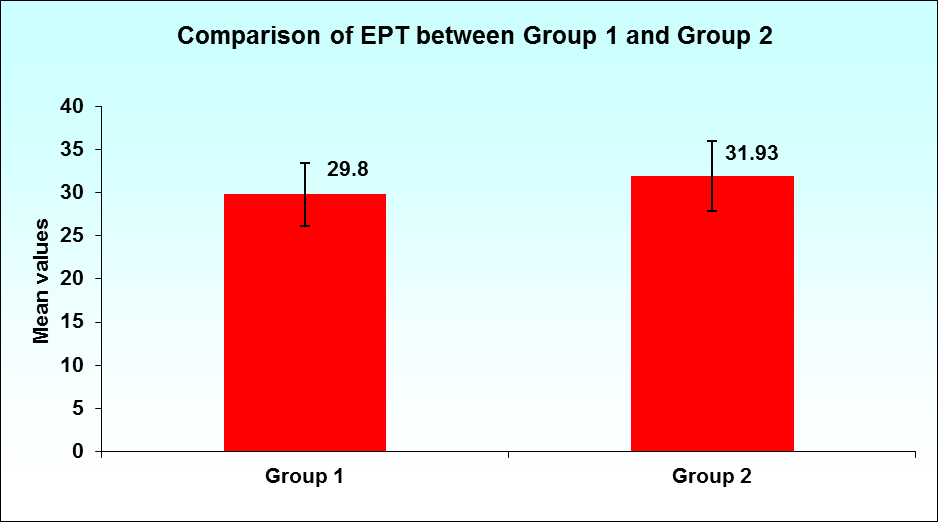Outcomes of coaxial microincision cataract surgery versus conventional phacoemulsification surgery
Abstract
Aim: To compare surgical parameters and visual outcomes of coaxial microincision cataract surgery (MICS) with standard phacoemulsification.
Methods: A prospective randomized study was conducted on 60 eyes of 60 patients with age-related uncomplicated cataract who underwent: standard phacoemulsification surgery (30 eyes) i.e., Group 1, or coaxial MICS (30 eyes) i.e., Group 2. Intraoperative parameters were mean effective phacoemulsification power (EPP), effective phacoemulsification time (EPT), and total volume of balanced salt solution (BSS) used. Best-corrected visual acuity (BCVA) and surgically induced astigmatism (SIA) were evaluated pre- and postoperatively.
Results: Mean BCVA at 6 weeks was 0.04 ± 0.07 in Group 1 and 0.05 ± 0.08 in Group 2. No significant difference was observed in SIA between the two groups. Mean EPT was 29.80 ± 3.67 seconds in Group 1 and 31.93 ± 4.08 seconds in Group 2. The mean total EPP in Group 1 was 35.77 ± 5.17%, whereas it was 33.70 ± 3.05% in Group 2. There was a significant statistical difference between mean EPP and EPT in the two groups. Mean total BSS volume used in Group 1 was 128.83 ± 19.81 ml, whereas it was 139.33 ± 13.57 ml in Group 2.
Conclusion: Although EPT and BSS volume used were significantly higher in coaxial MICS, the postoperative results of the two techniques were comparable.
References
2. Fletcher A, Kumar V, Selvaraj S. The Madurai Intra Ocular Study III: Visual functioning and quality of life outcomes. Am J Ophthalmol. 1998;125:26-35.
3. Kohnen S, Neuber R, Kohnen T. Effect of temporal and nasal unsutured limbal incisions on induced astigmatism after phacoemulsification. J Cataract Refract Surg. 2002;28:821-825.
4. Kelman CD. Phacoemulsification and aspiration; a new technique for cataract removal; a preliminary report. Am J Ophthalmol. 1967; 64:23-35.
5. Paton D, Ryan S. Present trends in incision and closure of cataract wound. Highlights Ophthalmol 1973;14:3-10.
6. Alió JL, Rodriguez-Prats JL, Galal A. Micro-incision cataract surgery. Highlights of Ophthalmology International: Miami, USA;2004.
7. Agarwal A, Agarwal A, Agarwal S, Narang P, Narang S. Phakonit: phacoemulsification through a 0.9 mm corneal incision. J Cataract Refract Surg. 200l; 27(10):1548-1552.
8. Tsuneoka H, Shiba T, Takahashi Y. Ultrasonic phacoemulsification using a 1.4 mm incision: clinical results. J Cataract Refract. Surg. 2002;28(1):81-86.
9. Weikert MP. Update on bimanual microincisional cataract surgery. Curr Opinion Ophthalmol. 2006;17:62-67.
10. Dosso AA, Cottet L, Burgener ND, Di Nardo S. Outcomes of coaxial microincision cataract surgery versus conventional coaxial cataract surgery. J Cataract Refract Surg. 2008;34:284-288.
11. Alio J, Rodriguez-Prats JL, Galal A, Ramzy M. Outcomes of microincision cataract surgery versus coaxial phacoemulsification. Ophthalmology. 2005;112(11):1997-2003.
12. Linebarger EJ, Hardten DR, Shah GK, Lindstrom RL. Phacoemulsification and modern cataract surgery. Surv Ophthalmol. 1999; 44:123-147.
13. Dick HB, Schwenn O, Krummenauer F, Krist R, Pfeiffer N. Inflammation after sclerocorneal versus clear corneal tunnel phacoemulsification. Ophthalmology. 2000;107:241-247.
14. Lundstrom M. Endophthalmitis and incision construction. Curr Opinion Ophthalmology. 2006;17:68-71.
15. Kurz S, Krummenauer F, Gabriel P. Biaxial microincision versus coaxial small incision clear cornea cataract surgery. Ophthalmology. 2006;113(10):1818-1826
16. Crema AS, Walsh A, Yamane Y, Nosé W. Comparative study of coaxial phacoemulsification and microincision cataract surgery, J Cataract Refract Surg. 2007;33:1014-1018.
17. FC Donders, WD Moore. On the anomalies of accommodation and refraction of the eye. London: New Sydenham Society; 1864.
18. Wilczynski M, Supady E, Piotr L, Synder A, Palenga-Pydyn D, Omulecki W. Comparison of surgically induced astigmatism after coaxial phacoemulsification through 1.8 mm microincision and bimanual phacoemulsification through 1.7 mm microincision. J Cataract Refract Surg. 2009;35:1563-1569.
19. Dogru M, Honda R, Omoto M, et al. Early visual results with the reliable ThinOptX intra ocular lens. J Cataract Refract Surg. 2004;30(3):558-565.
20. Wilczyńska O, Wilczyński M, Omulecki W. Surgically induced astigmatism after bimanual phacoemulsification through microincision and after standard phacoemulsification.2010;112(4-6):115-119.
21. Kahraman G, Amon M, Franz C. Intraindividual comparison of surgical trauma after bimanual microincision and conventional small-incision coaxial phacoemulsification. J. Cataract Refract. Surg. 2007;33(4):618–622.
22. Saeed A, O’Connor J, Cunnife G. Uncorrected visual acuity in the immediate postoperative period following uncomplicated cataract surgery: bimanual microincision cataract surgery versus standard coaxial phacoemulsification. Int Ophthalmol. 2009;29(5):393-400.
23. Mencucci R, Ponchietti C, Virgili G. Corneal endothelial damage after cataract surgery: microincision versus standard technique. J. Cataract Refract. Surg. 2006;32(8):1351-1354.
24. Tanaka T, Koshika S, Usui M. Cataract surgery using the bimanual phacoemulsification technique with an Accurus system and Mackool microphaco tip. J Cataract Refract Surg. 2007;33:1770-1774.

Copyright (c) 2019 Asian Journal of Ophthalmology

This work is licensed under a Creative Commons Attribution 4.0 International License.
Authors who publish with this journal agree to the following terms:
- Authors retain copyright and grant the journal right of first publication, with the work twelve (12) months after publication simultaneously licensed under a Creative Commons Attribution License that allows others to share the work with an acknowledgement of the work's authorship and initial publication in this journal.
- Authors are able to enter into separate, additional contractual arrangements for the non-exclusive distribution of the journal's published version of the work (e.g., post it to an institutional repository or publish it in a book), with an acknowledgement of its initial publication in this journal.
- Authors are permitted and encouraged to post their work online (e.g., in institutional repositories or on their website) prior to and during the submission process, as it can lead to productive exchanges, as well as earlier and greater citation of published work (See The Effect of Open Access).


